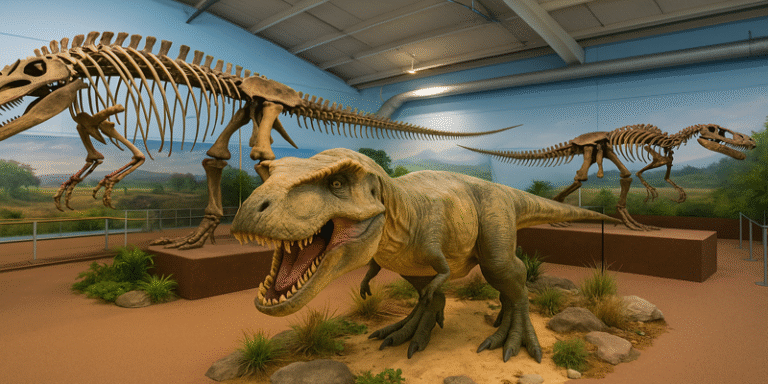The Isle of Wight is renowned not only for its coastal charm and scenic landscapes, but also for being one of the most significant palaeontological sites in Europe. At the heart of this prehistoric heritage is Dinosaur Isle Museum, a family-friendly attraction that immerses visitors in the ancient world of dinosaurs. Located in Sandown, this purpose-built museum is a must-visit destination for tourists interested in natural history, science, and interactive education.
A Legacy of Fossil Discovery
The Isle of Wight is often dubbed “Dinosaur Island” due to the abundance of fossilised remains discovered along its coastlines, particularly from the Early Cretaceous period. According to Sweetman (2007), the region’s Wessex Formation has yielded a rich diversity of vertebrate fossils, making it a global hotspot for dinosaur enthusiasts and researchers alike. The Dinosaur Isle Museum, opened in 2001, capitalises on this heritage, showcasing over 1,000 specimens, including fossilised bones, teeth, and footprints.
An Educational and Interactive Experience
One of the defining features of the museum is its interactive approach to education. Designed by leading palaeontologists and museum experts, the exhibits are laid out in chronological order, allowing visitors to explore the development of life from prehistoric times to the present day (Hooker & Sweetman, 2009). Children and adults alike can engage with replica skeletons, life-sized dinosaur models, and hands-on fossil handling sessions.
Importantly, the museum houses many original fossils unearthed from nearby beaches such as Yaverland, Compton Bay, and Culver Cliff. These areas are still active fossil hunting sites and often serve as field trip locations organised by the museum itself (Martill et al., 2019).
Family-Friendly Facilities and Programmes
The museum offers much more than static exhibits. Its education centre regularly hosts workshops, talks, and guided fossil walks, making it particularly popular with schools and family tourists. According to Visit Isle of Wight (2025), the museum receives tens of thousands of visitors annually, with families making up a significant proportion.
The on-site gift shop and café also contribute to a convenient and enjoyable visit, while the museum’s location—just metres from Sandown Beach—makes it easy to pair a museum visit with a day at the seaside.
A Centre of Scientific Research
While it is a popular tourist destination, Dinosaur Isle is also a serious research institution. Researchers such as Sweetman and Munt (2024) have published extensively on the vertebrate fauna of the Isle of Wight, drawing on specimens from the museum’s collection. The museum’s close links with universities and academic institutions make it a living archive of Cretaceous biodiversity.
It also plays a key role in geoconservation, helping to preserve and document important fossil sites. Munt (2016) stresses that the museum contributes to the sustainable management of geological heritage, balancing public engagement with scientific responsibility.
Economic and Cultural Impact on the Island
From a tourism perspective, Dinosaur Isle plays a pivotal role in the Isle of Wight’s economy. The island hosts an estimated 2.3 million tourists annually, contributing over £300 million to the local economy (Isle of Wight Council, 2023). Attractions like Dinosaur Isle diversify the island’s appeal, particularly during off-peak seasons.
Moreover, the museum supports local employment, educational services, and small businesses, such as fossil tour guides and craft sellers who operate in the area. It is a central part of the island’s cultural identity, blending scientific discovery with community engagement.
Accessible Tourism and Sustainability
The museum is designed to be fully accessible, with facilities accommodating wheelchairs, pushchairs, and visitors with additional needs. Sustainability is also a growing priority. Initiatives include reducing single-use plastics, using energy-efficient lighting, and promoting eco-tourism principles (Simpson, 2018).
Being part of the UNESCO Isle of Wight Biosphere Reserve, Dinosaur Isle plays a role in educating the public about sustainable tourism and biodiversity conservation (Downes, 2021).
Visitor Tips and What to Expect
Visitors to Dinosaur Isle can expect a well-structured and engaging experience. A standard visit typically lasts between 1.5 and 2 hours, with highlights including:
- The Animatronic Dinosaur Hall, featuring roaring, moving models.
- The Fossil Preparation Lab, where guests can watch real palaeontologists at work.
- Interactive digital displays and touch-screen exhibits that explain complex geological processes in accessible language.
- Seasonal events such as Dino Days, Easter Egg Fossil Hunts, and summer palaeontology camps.
It’s advised to book in advance during school holidays, as the museum can get very busy. Combining the visit with a beach fossil hunt or a trip to nearby Sandown Pier can round out a perfect family day out.
A Time-Travel Experience for All Ages
Whether you’re a seasoned fossil hunter or a family looking for an educational day trip, Dinosaur Isle Museum offers a compelling blend of science, history, and fun. Its contribution to both tourism and palaeontology makes it a unique institution—not just on the Isle of Wight, but in the UK as a whole.
With its interactive displays, family programmes, and strong scientific foundations, Dinosaur Isle is more than a museum; it is a gateway to deep time, a place where young and old can marvel at the mysteries of the Mesozoic.
References
Bowden, A., Lomax, D.R., Robinson, P. and Sweetman, S.C., 2014. The History of Palaeontology at Doncaster Museum. The Geological Curator, 10(1), pp.29-34. Available at: https://www.geocurator.org.
Downes, J., 2021. Isle of Wight: Landscape and Geology. London: Routledge.
Hooker, J.J. and Sweetman, S.C., 2009. Early Cretaceous and Paleogene vertebrate localities of the Isle of Wight, Southern England. Society of Vertebrate Paleontology Annual Meeting. Available at: https://www.researchgate.net.
Isle of Wight Council, 2023. Tourism and the Visitor Economy Strategy 2023–2028. [online] Available at: https://www.iow.gov.uk.
Martill, D.M., Sweetman, S.C., and Munt, M., 2019. The Cretaceous succession between Yaverland and Culver Cliff, Isle of Wight. ResearchGate. Available at: https://www.researchgate.net.
Munt, M., 2016. Geoheritage Case Study: The Isle of Wight, England. In: Hose, T.A. and Vasiljević, D.A. (eds), Geoheritage and Geotourism: A European Perspective, London: Springer.
Simpson, M., 2018. Geotourism and Geoconservation on the Isle of Wight, UK: Balancing science with commerce. Geoconservation Research, 1(2), pp.101-115. Available at: https://oiccpress.com.
Sweetman, S.C., 2007. Aspects of the microvertebrate fauna of the Early Cretaceous (Barremian) Wessex Formation of the Isle of Wight, southern England. PhD thesis, University of Portsmouth. Available at: https://researchportal.port.ac.uk.
Visit Isle of Wight, 2025. Dinosaur Isle Museum. [online] Available at: https://www.visitisleofwight.co.uk.









